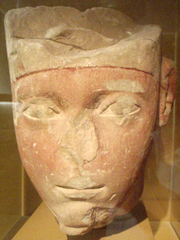Portal:Ancient Egypt/Selected biography/2

Amenhotep I (sometimes read as Amenophis I and meaning "Amun is satisfied") was the second Pharaoh of the Eighteenth Dynasty of Egypt. His reign is generally dated from 1526 to 1506 BC. He was born to Ahmose I and Ahmose-Nefertari, but had at least two elder brothers, Ahmose-ankh and Ahmose Sapair, and was not expected to inherit the throne. However, sometime in the eight years between Ahmose I's 17th regnal year and his death, his heir apparent died and Amenhotep became crown prince. He then acceded to the throne and ruled for about 21 years.
Although his reign is poorly documented, it is possible to piece together a basic history from available evidence. He inherited the kingdom formed by his father's military conquests and maintained dominance over Nubia and the Nile Delta, but probably did not attempt to keep power in Syria-Canaan. He continued to rebuild temples in Upper Egypt, and revolutionized mortuary complex design by separating his tomb from his mortuary temple, setting a trend which would persist throughout the New Kingdom. After his death, he was deified into the patron god of Deir el-Medina.
Amenhotep was deified upon his death and made the patron deity of the village which he opened at Deir el-Medina. His mother, who lived at least one year longer than he did, was also deified upon her death and became part of his litany. When being worshiped, he had three deific manifestations: "Amenhotep of the Town," "Amenhotep Beloved of Amun," and "Amenhotep of the Forecourt," and was known as a god who produced oracles. Some of the questions asked of him have been preserved on ostraca from Deir el-Medina, and appear to have been phrased in such a way that the idol of the king could nod (or be caused to nod) the answer.
Text is available under the CC BY-SA 4.0 license; additional terms may apply.
Images, videos and audio are available under their respective licenses.
